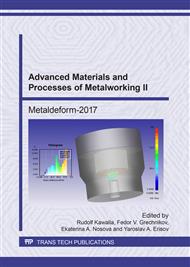[1]
GOST R 51756-2001. Aluminum cans of deep drawing with easy open ends. Specifications. Enforced on 01. 01. 2002. М.: Standards Publishing, 2001, 30 pp.
Google Scholar
[2]
Pat. 5685189 US, B21D 51/44 (20060101); B21D 51/38 (20060101); B21D 051/44 Method and apparatus for producing container body end countersink / Nguyen; Tuan A. (Golden, CO), Farley; Todd W. (Arvada, CO); Patent holder Ball Corporation (Muncie, IN). – №08/589, 602; Application dated 22. 01. 96; date of publication 11. 11. 97. – 24 pp.
Google Scholar
[3]
E.V. Aryshenskii, V.Y. Aryshenskii, A.F. Grechnikova, Beglov E.D., Evolution of Texture and Microstructure in the Production of Sheets and Ribbons from Aluminum Alloy 5182 in Modern Rolling Facilities. Metal Science and Heat Treatment, 2014, 56(7-8): 347-352.
DOI: 10.1007/s11041-014-9760-7
Google Scholar
[4]
E.V. Aryshenskii, L.V. Zhuravel, V.Y. Aryshenskii, E.D. Beglov, Effect of softening on the mechanical properties and formability of ribbon from alloy 3104. Metal Science and Heat Treatment, 2014, 56(1-2): 14-17.
DOI: 10.1007/s11041-014-9694-0
Google Scholar
[5]
А.D. Tomlenov, Theory of Metals Plastic Deformation. М.: Metallurgiya, 1972. 408 pp.
Google Scholar
[6]
V.L. Kolmogorov, Stress, strain, fracture. М.: Metallyrgiya., 1970. 229 pp.
Google Scholar
[7]
A. Iu. Averkiev, Methods of Sheet Metal Formability Evaluation. М.: Mashinostroenie., 1985. 176 pp.
Google Scholar
[8]
V.L. Kolmogorov, Mechanics of Metal Forming. М.: Metallurgiya., 1986. 688 с.
Google Scholar
[9]
I.A. Choudhury, O.H. Lai, L.T. Wong, PAM-STAMP in the Simulation of Stamping Process of an Automotive Component. Simulation Modeling Practice and Theory, 2006, 14: 71-81.
DOI: 10.1016/j.simpat.2005.04.002
Google Scholar
[10]
S. Ilmira, S. Aleksei, E. Yaroslav, Computer simulation of the half-tore forming process from a ring blank. Key Engineering Materials, 2016, 684: 227-233.
DOI: 10.4028/www.scientific.net/kem.684.227
Google Scholar
[11]
R. Hill, The Mathematical Theory of Plasticity. Oxford: Clarendon Press, (1950).
Google Scholar
[12]
Z. Gronostajski, The Constitutive Equations for FEM Analysis. Journal of Materials Processing Technology, 2000, 106: 40-44.
DOI: 10.1016/s0924-0136(00)00635-x
Google Scholar
[13]
BS EN 541: 2006. Aluminium and aluminium alloys. Rolled products for cans, closures and lids. Specifications. 01. 12. 2006. CEN/TC 132, 2006. 24 с.
DOI: 10.3403/00580491
Google Scholar
[14]
М.V. Storozhev, Е.А. Popov, Theory of Metal Forming, М.: Mashinostroenie, 1977, 423 pp.
Google Scholar


